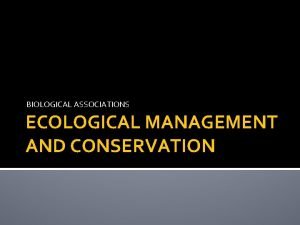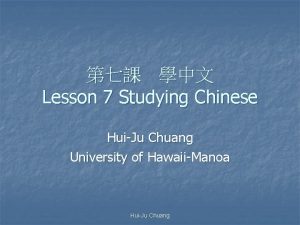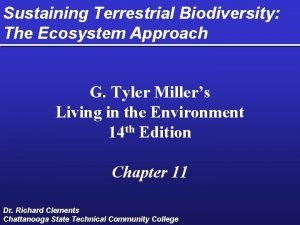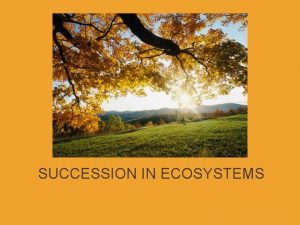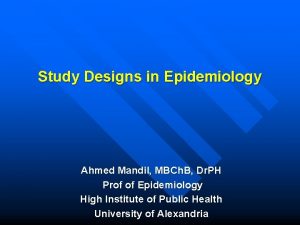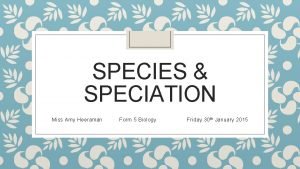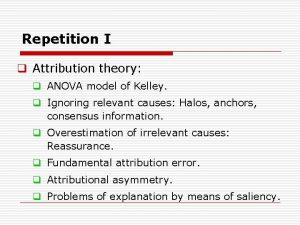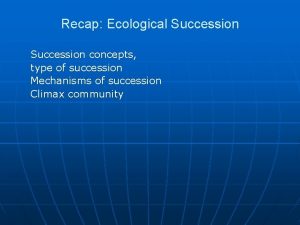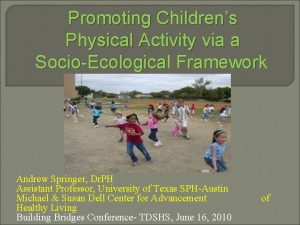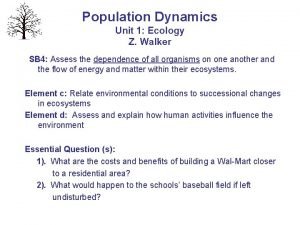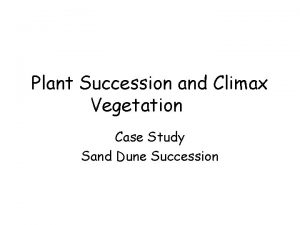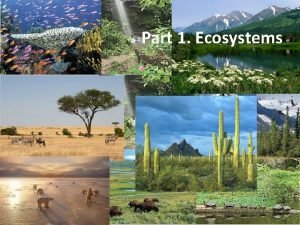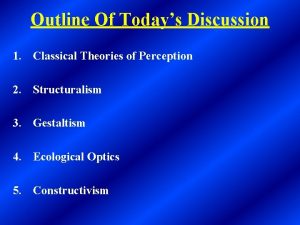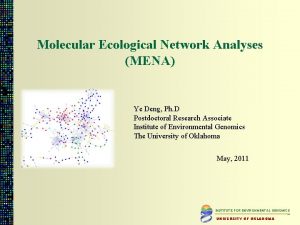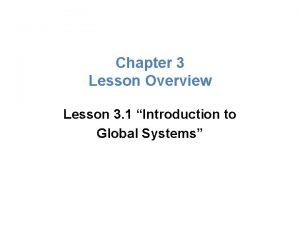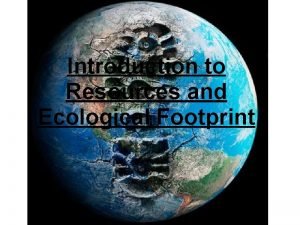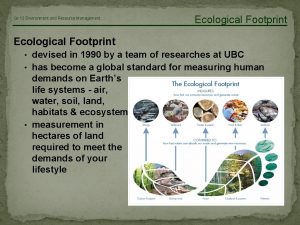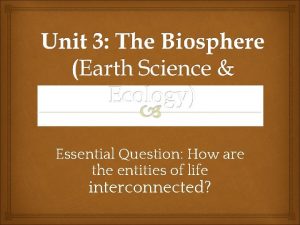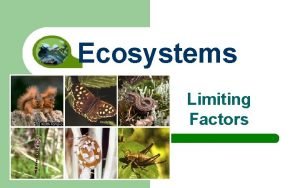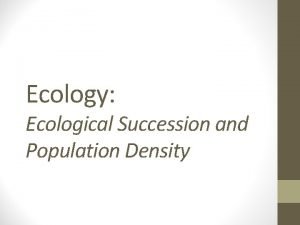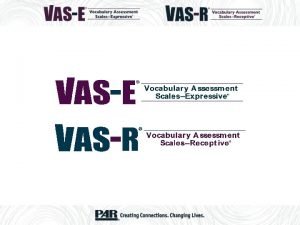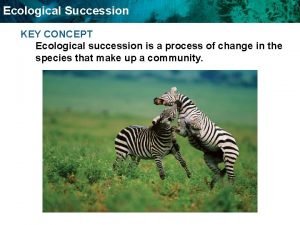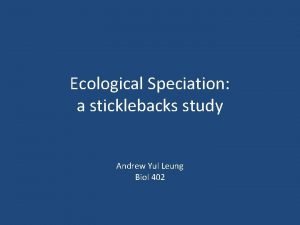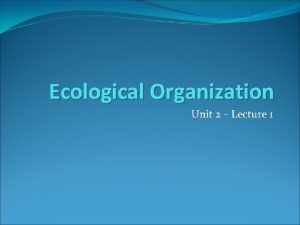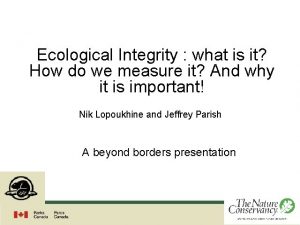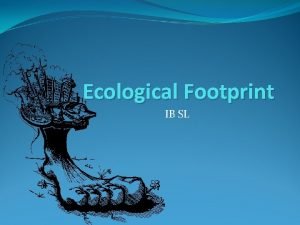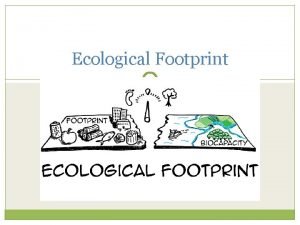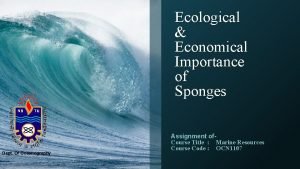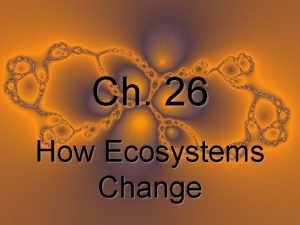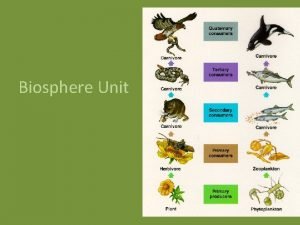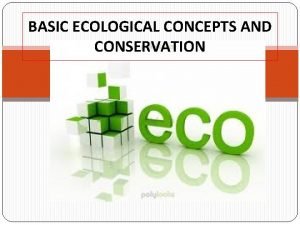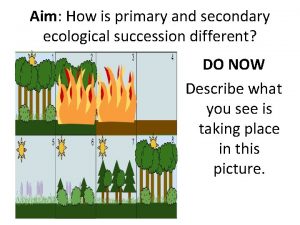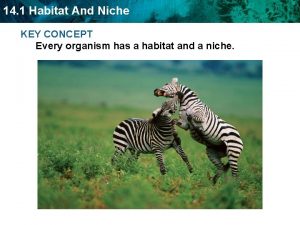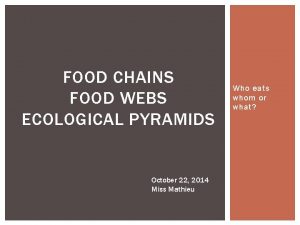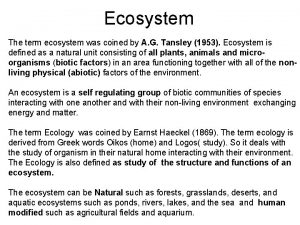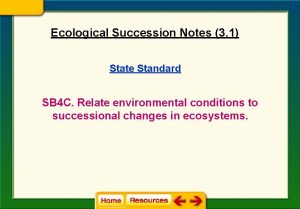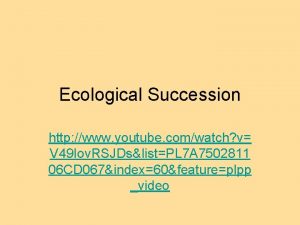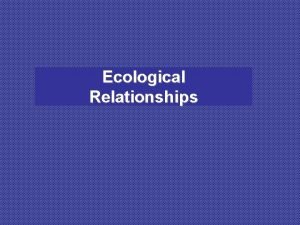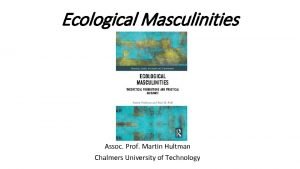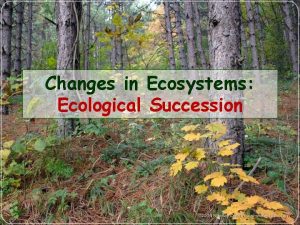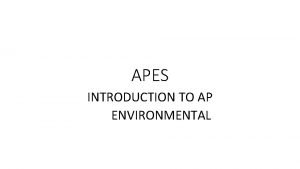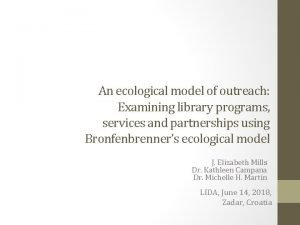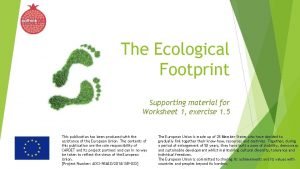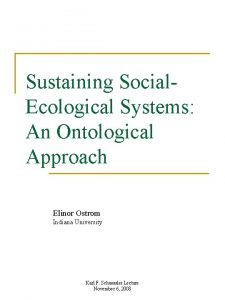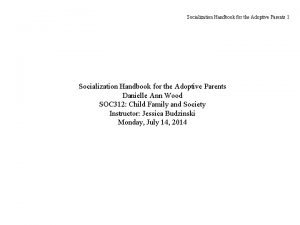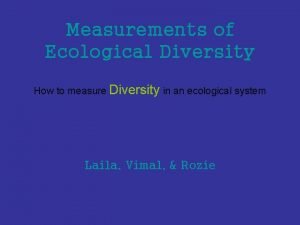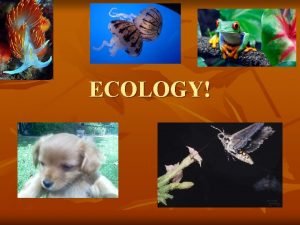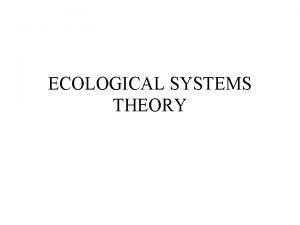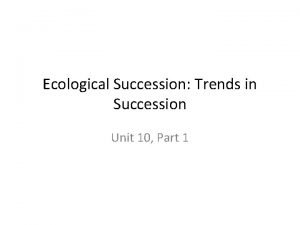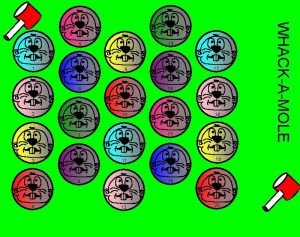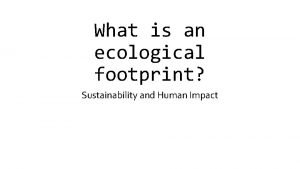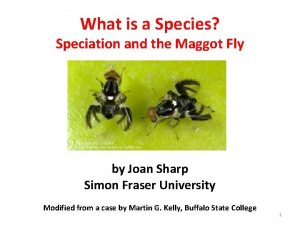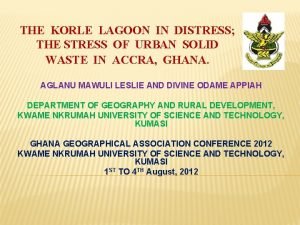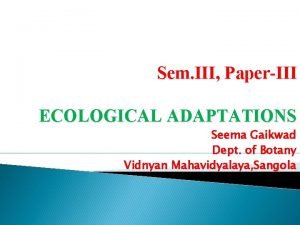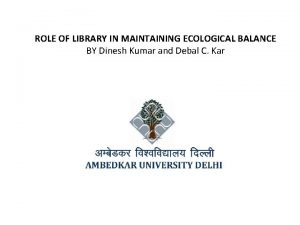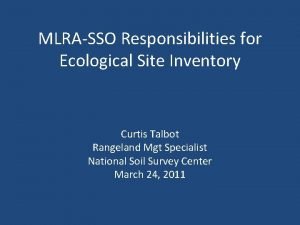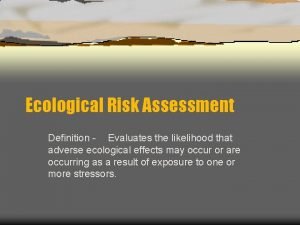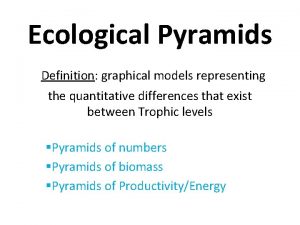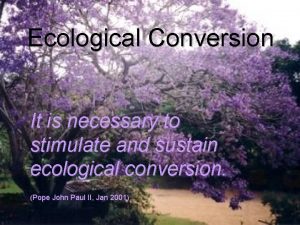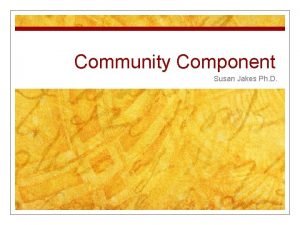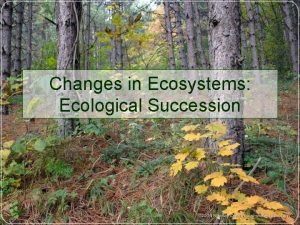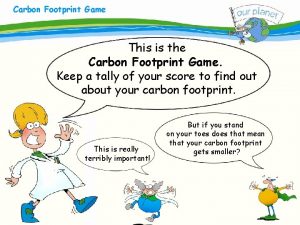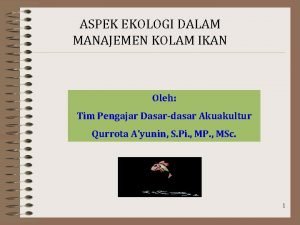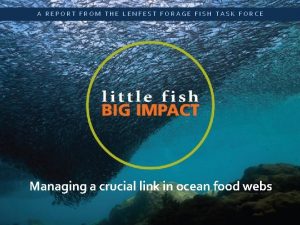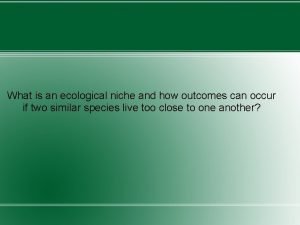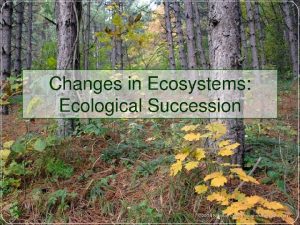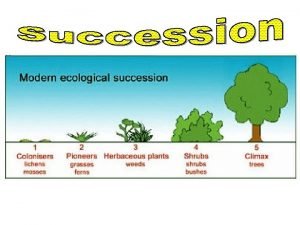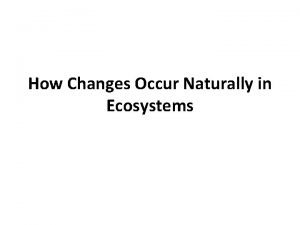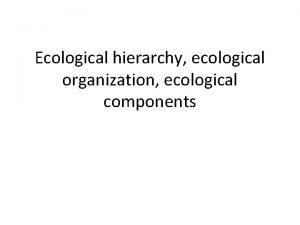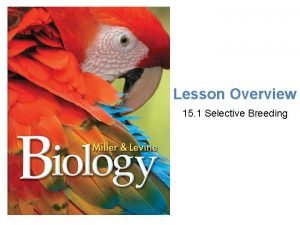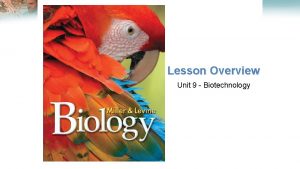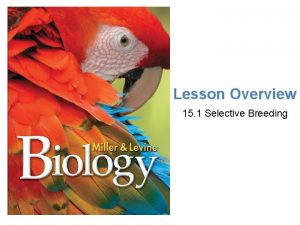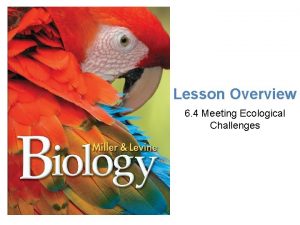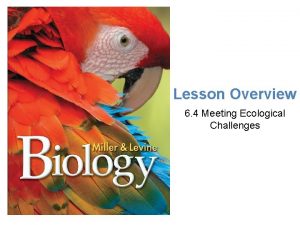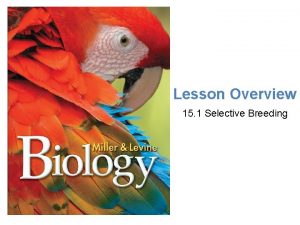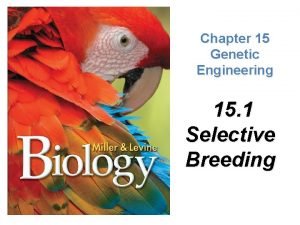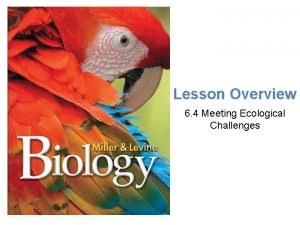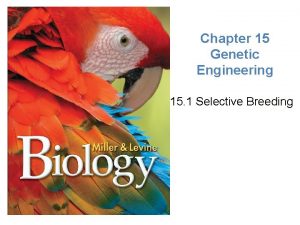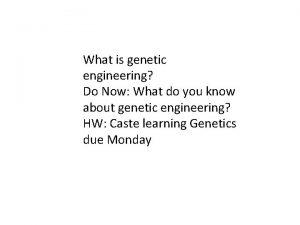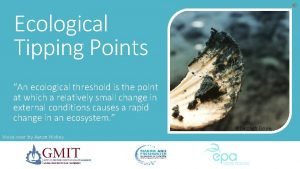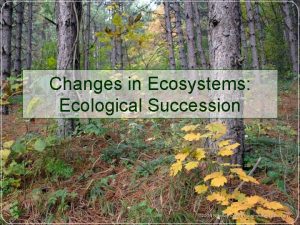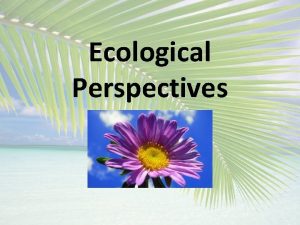Lesson Overview Meeting Ecological Challenges Lesson Overview 15






















































































































- Slides: 118

Lesson Overview Meeting Ecological Challenges Lesson Overview 15. 1 Selective Breeding

Lesson Overview Meeting Ecological Challenges THINK ABOUT IT Would you be surprised to learn that popcorn is one of the earliest examples of human efforts to select and improve living organisms for our benefit? Corn as we know it was domesticated at least 6000 years ago by Native Americans living in Mexico. A tiny kernel of popped corn found in a cave in New Mexico is more than 5000 years old!

Lesson Overview Meeting Ecological Challenges Selective Breeding Humans use selective breeding, which takes advantage of naturally occurring genetic variation, to pass wanted traits on to the next generation of organisms. Humans use selective breeding to produce animals with certain desired traits. Selective breeding allows only those animals with wanted characteristics to produce the next generation.

Lesson Overview Meeting Ecological Challenges Selective Breeding For thousands of years, we’ve produced new varieties of cultivated plants and nearly all domestic animals by selectively breeding for particular traits. Native Americans selectively bred teosinte, a wild grass native to central Mexico, to produce corn, a far more productive and nutritious plant. Corn is now one of the world’s most important crops. There are two common methods of selective breeding—hybridization and inbreeding.

Lesson Overview Meeting Ecological Challenges Hybridization American botanist Luther Burbank developed more than 800 varieties of plants using selective breeding methods. One method Burbank used was hybridization, crossing dissimilar individuals to bring together the best of both organisms. Hybrids —the individuals produced by such crosses are often hardier than either of the parents.

Lesson Overview Meeting Ecological Challenges Hybridization Many of Burbank’s hybrid crosses combined the disease resistance of one plant with the food-producing capacity of another. The result was a new line of plants that had the traits farmers needed to increase food production. July Elberta peaches, for example, are among Burbank’s most successful varieties.

Lesson Overview Meeting Ecological Challenges Inbreeding To maintain desirable characteristics in a line of organisms, breeders often use inbreeding, the continued breeding of individuals with similar characteristics. Most of the members of a breed are genetically similar, which increases the chance that a cross between two individuals will bring together two recessive alleles for a genetic defect.

Lesson Overview Meeting Ecological Challenges Increasing Variation When scientists manipulate the genetic makeup of an organism, they are using biotechnology. Biotechnology is the application of a technological process, invention, or method to living organisms. Selective breeding is one form of biotechnology important in agriculture and medicine, but there are many others. What genes are added to make these super tomatoes?

Lesson Overview Meeting Ecological Challenges Bacterial Mutations occur spontaneously, but breeders can increase the mutation rate of an organism by using radiation or chemicals. Many mutations are harmful to the organism, but breeders can often produce a few mutants—individuals with mutations—with useful characteristics that are not found in the original population. For example, scientists have developed hundreds of useful mutant bacterial strains by treating bacteria with radiation or chemicals. Certain strains of oil-digesting bacteria are effective for cleaning up oil spills, and scientists are currently working to produce bacteria that can clean up radioactive substances and metal pollution in the environment. HOW WILL THIS CHANGE THE ENVIRONMENT? ? ?

Lesson Overview Meeting Ecological Challenges Polyploid Plants • Drugs that prevent the separation of chromosomes during meiosis are very useful in plant breeding. These drugs can produce cells that have many times the normal number of chromosomes. • Plants grown from these cells are called polyploid because they have many sets of chromosomes. • Polyploidy is usually fatal in animals, but plants are much better at tolerating extra sets of chromosomes. http: //waynesword. palomar. edu/hybrids 1. htm

Lesson Overview Meeting Ecological Challenges Polyploidy in humans Human disorders due to chromosome alterations in autosomes (Chromosomes 1 -22). There only 3 trisomies that result in a baby that can survive for a time after birth; the others are too devastating and the baby usually dies in utero. 1. Down syndrome (trisomy 21): The result of an extra copy of chromosome 21. 1. Patau syndrome (trisomy 13): serious eye, brain, circulatory defects as well as cleft palate. 1: 5000 live births. Children rarely live more than a few months. 2. Edward's syndrome (trisomy 18): almost every organ system affected 1: 10, 000 live births. Children with full Trisomy 18 generally do not live more than a few months.

Lesson Overview Meeting Ecological Challenges Polyploid Plants Polyploidy can quickly produce new species of plants that are larger and stronger than their diploid relatives. A number of important crop plants, including bananas, have been produced in this way.

Lesson Overview Meeting Ecological Challenges Lesson Overview 15. 2 Recombinant DNA

Lesson Overview Meeting Ecological Challenges THINK ABOUT IT Suppose you have an electronic game you want to change. Knowing that the game depends on a coded program in a computer microchip, you’d need a way to get the existing program out of the microchip, read the program, make the changes you want, and put the modified code back into the microchip. What does this scenario have to do with genetic engineering? Just about everything.

Lesson Overview Meeting Ecological Challenges Copying DNA How do scientists copy the DNA of living organisms? Polymerase Chain Reaction Method: • copy a gene is to heat a piece of DNA, which separates its two strands. • Then, as the DNA cools, primers bind to the single strands. • DNA polymerase starts copying the region between the primers. • These copies can serve as templates to make still more copies.

Lesson Overview Meeting Ecological Challenges Copying DNA Until recently plant and animal breeders could only work with variations that already exist in nature, and the changes produced by mutation were unpredictable. Today genetic engineers can transfer certain genes from one organism to another, designing new living things to meet specific needs.

Lesson Overview Meeting Ecological Challenges Copying DNA It is relatively easy to extract DNA from cells and tissues. The extracted DNA can be cut into fragments of manageable size using restriction enzymes. These restriction fragments can then be separated according to size, using gel electrophoresis or another similar technique.

Lesson Overview Meeting Ecological Challenges Finding Genes In 1987, Douglas Prasher, a biologist at Woods Hole Oceanographic Institute in Massachusetts, wanted to find a specific gene in a jellyfish that codes for a molecule called green fluorescent protein, or GFP. This natural protein, found in the jellyfish, absorbs energy from light and makes parts of the jellyfish glow. Prasher thought that GFP from the jellyfish could be linked to a protein when it was being made in a cell, a bit like attaching a light bulb to that molecule.

Lesson Overview Meeting Ecological Challenges Finding Genes To find the GFP gene, Prasher compared part of the amino acid sequence of the GFP protein to a genetic code table and was able to predict a probable m. RNA base sequence that would code for this sequence of amino acids. Next, Prasher used a complementary base sequence to “attract” an m. RNA that matched his prediction and would bind to that sequence by base pairing. After screening a genetic “library” with thousands of different m. RNA sequences from the jellyfish, he found one that bound perfectly.

Lesson Overview Meeting Ecological Challenges Finding Genes To find the actual gene that produced GFP, Prasher took a gel in which restriction fragments from the jellyfish genome had been separated and found that one of the fragments bound tightly to the m. RNA. That fragment contained the actual gene for GFP. This method is called Southern blotting, after its inventor, Edwin Southern.

Lesson Overview Meeting Ecological Challenges Finding Genes Today it is often quicker and less expensive for scientists to search for genes in computer databases where the complete genomes of many organisms are available.

Lesson Overview Meeting Ecological Challenges Polymerase Chain Reaction Once biologists find a gene, a technique known as polymerase chain reaction (PCR) allows them to make many copies of it. 1. A piece of DNA is heated, which separates its two strands.

Lesson Overview Meeting Ecological Challenges Polymerase Chain Reaction 2. At each end of the original piece of DNA, a biologist adds a short piece of DNA that complements a portion of the sequence. These short pieces are known as primers because they prepare, or prime, a place for DNA polymerase to start working.

Lesson Overview Meeting Ecological Challenges Polymerase Chain Reaction 3. DNA polymerase copies the region between the primers. These copies then serve as templates to make more copies. 4. In this way, just a few dozen cycles of replication can produce billions of copies of the DNA between the primers.

Lesson Overview Meeting Ecological Challenges Changing DNA How is recombinant DNA used? Recombinant-DNA technology—joining together DNA from two or more sources—makes it possible to change the genetic composition of living organisms.

Lesson Overview Meeting Ecological Challenges Changing DNA Scientists began wondering if it might be possible to change the DNA of a living cell, and many of them realized this had already been accomplished decades earlier in Frederick Griffith’s bacterial transformation experiments. During transformation, a cell takes in DNA from outside the cell, and that added DNA becomes a component of the cell’s own genome. Griffith’s extract of heat-killed bacteria contained DNA fragments, which were taken up by live bacteria, transforming the live bacteria and changing their characteristics.

Lesson Overview Meeting Ecological Challenges Combining DNA Fragments Today, scientists can produce custom-built DNA molecules in the lab and then insert those molecules—along with the genes they carry—into living cells. Machines known as DNA synthesizers are used to produce short pieces of DNA, up to several hundred bases in length. These synthetic sequences can then be joined to natural sequences using DNA ligase or other enzymes that splice DNA together.

Lesson Overview Meeting Ecological Challenges Combining DNA Fragments A gene from one organism can be attached to the DNA of another organism. Restriction enzymes cut DNA at specific sequences, producing “sticky ends, ” which are single-stranded overhangs of DNA.

Lesson Overview Meeting Ecological Challenges Combining DNA Fragments If two DNA molecules are cut with the same restriction enzyme, their sticky ends will bond to a DNA fragment that has the complementary base sequence. DNA ligase then joins the two fragments. The resulting molecules are called recombinant DNA.

Lesson Overview Meeting Ecological Challenges Combining DNA Fragments Recombinant-DNA technology—joining together DNA from two or more sources—makes it possible to change the genetic composition of living organisms. By manipulating DNA in this way, scientists can investigate the structure and functions of genes.

Lesson Overview Meeting Ecological Challenges Plasmids and Genetic Markers Scientists working with recombinant DNA soon discovered that many of the DNA molecules they tried to insert into host cells simply vanished because the cells often did not copy, or replicate, the added DNA. Today scientists join recombinant DNA to another piece of DNA containing a replication “start” signal. This way, whenever the cell copies its own DNA, it copies the recombinant DNA too.

Lesson Overview Meeting Ecological Challenges Plasmids and Genetic Markers In addition to their own large chromosomes, some bacteria contain small circular DNA molecules known as plasmids. Joining DNA to a plasmid, and then using the recombinant plasmid to transform bacteria, results in the replication of the newly added DNA along with the rest of the cell’s genome.

Lesson Overview Meeting Ecological Challenges Plasmids and Genetic Markers Plasmids used for genetic engineering typically contain a replication start signal, called the origin of replication (ori), and a restriction enzyme cutting site, such as Eco. RI.

Lesson Overview Meeting Ecological Challenges Plasmids and Genetic Markers Plasmids are also found in yeasts, which are single-celled eukaryotes that can be transformed with recombinant DNA as well. Biologists working with yeasts can construct artificial chromosomes containing centromeres, telomeres, and replication start sites. These artificial chromosomes greatly simplify the process of introducing recombinant DNA into the yeast genome.

Lesson Overview Meeting Ecological Challenges Plasmids and Genetic Markers Bacteria can be transformed using recombinant plasmids. Scientists can insert a piece of DNA into a plasmid if both the plasmid and the target DNA have been cut by the same restriction enzymes to create sticky ends.

Lesson Overview Meeting Ecological Challenges Plasmid DNA Transformation Using Human Growth Hormone

Lesson Overview Meeting Ecological Challenges Plasmids and Genetic Markers The new combination of genes is then returned to a bacterial cell, which replicates the recombinant DNA over and over again and produces human growth hormone.

Lesson Overview Meeting Ecological Challenges Plasmids and Genetic Markers The recombinant plasmid has a genetic marker, such as a gene for antibiotic resistance. A genetic marker is a gene that makes it possible to distinguish bacteria that carry the plasmid from those that don’t. This plasmid contains the antibiotic resistance genes tetr and ampr. After transformation, the bacteria culture is treated with an antibiotic. Only those cells that have been transformed survive, because only they carry the resistance gene.

Lesson Overview Meeting Ecological Challenges Transgenic Organisms How can genes from one organism be inserted into another organism?

Lesson Overview Meeting Ecological Challenges Transgenic Organisms How can genes from one organism be inserted into another organism? Transgenic organisms can be produced by the insertion of recombinant DNA into the genome of a host organism.

Lesson Overview Meeting Ecological Challenges Transgenic Organisms The universal nature of the genetic code makes it possible to construct organisms that are transgenic, containing genes from other species. Transgenic organisms can be produced by the insertion of recombinant DNA into the genome of a host organism. Like bacterial plasmids, the DNA molecules used for transformation of plant and animal cells contain genetic markers that help scientists identify which cells have been transformed.

Lesson Overview Meeting Ecological Challenges Transgenic Organisms Transgenic technology was perfected using mice in the 1980 s. Genetic engineers can now produce transgenic plants, animals, and microorganisms. By examining the traits of a genetically modified organism, it is possible to learn about the function of the transferred gene.

Lesson Overview Meeting Ecological Challenges Transgenic Plants Many plant cells can be transformed using Agrobacterium. In nature this bacterium inserts a small DNA plasmid that produces tumors in a plant’s cells. Scientists can deactivate the plasmid’s tumor-producing gene and replace it with a piece of recombinant DNA. The recombinant plasmid can then be used to infect and transform plant cells. The transformed cells can be cultured to produce adult plants.

Lesson Overview Meeting Ecological Challenges Transgenic Plants: Transforming a Plant with Agrobacterium

Lesson Overview Meeting Ecological Challenges Transgenic Plants There are other ways to produce transgenic plants as well. When their cell walls are removed, plant cells in culture will sometimes take up DNA on their own. DNA can also be injected directly into some cells. If transformation is successful, the recombinant DNA is integrated into one of the plant cell’s chromosomes.

Lesson Overview Meeting Ecological Challenges Transgenic Animals Scientists can transform animal cells using some of the same techniques used for plant cells. The egg cells of many animals are large enough that DNA can be injected directly into the nucleus. Once the DNA is in the nucleus, enzymes that are normally responsible for DNA repair and recombination may help insert the foreign DNA into the chromosomes of the injected cell.

Lesson Overview Meeting Ecological Challenges Transgenic Animals Recently it has become possible to eliminate particular genes by constructing DNA molecules with two ends that will sometimes recombine with specific sequences in the host chromosome. Once they recombine, the host gene normally found between those two sequences may be lost or specifically replaced with a new gene. This kind of gene replacement has made it possible to pinpoint the specific functions of genes in many organisms, including mice.

Lesson Overview Meeting Ecological Challenges Cloning A clone is a member of a population of genetically identical cells produced from a single cell The technique of cloning uses a single cell from an adult organism to grow an entirely new individual that is genetically identical to the organism from which the cell was taken. Clones of animals were first produced in 1952 using amphibian tadpoles. In 1997, Scottish scientist Ian Wilmut announced that he had produced a sheep, called Dolly, by cloning.

Lesson Overview Meeting Ecological Challenges Cloning Animal cloning uses a procedure called nuclear transplantation. The process combines an egg cell with a donor nucleus to produce an embryo. First, the nucleus of an unfertilized egg cell is removed.

Lesson Overview Meeting Ecological Challenges Cloning Next, the egg cell is fused with a donor cell that contains a nucleus, taken from an adult. The resulting diploid egg develops into an embryo, which is then implanted in the uterine wall of a foster mother, where it develops until birth. Cloned cows, pigs, mice, and even cats have since been produced using similar techniques.

Lesson Overview Meeting Ecological Challenges Cloning Animals—Nuclear Transplantation

Lesson Overview Meeting Ecological Challenges Lesson Overview 15. 3 Applications of Genetic Engineering

Lesson Overview Meeting Ecological Challenges THINK ABOUT IT Have you eaten any genetically modified food lately? If you’ve eaten corn, potatoes, or soy products in any of your meals this week, chances are close to 100 percent that you’ve eaten foods modified in some way by genetic engineering.

Lesson Overview Meeting Ecological Challenges Agriculture and Industry How can genetic engineering benefit agriculture and industry?

Lesson Overview Meeting Ecological Challenges Agriculture and Industry How can genetic engineering benefit agriculture and industry? Ideally, genetic modification could lead to better, less expensive, and more nutritious food as well as less harmful manufacturing processes.

Lesson Overview Meeting Ecological Challenges Agriculture and Industry Almost everything we eat and much of what we wear come from living organisms. Researchers have used genetic engineering to try to improve the products we get from plants and animals. Genetic modification could lead to better, less expensive, and more nutritious food as well as less harmful manufacturing processes.

Lesson Overview Meeting Ecological Challenges GM Crops Since their introduction in 1996, genetically modified (GM) plants have become an important component of our food supply. One genetic modification uses bacterial genes that produce a protein known as Bt toxin. This toxin is harmless to humans and most other animals, but enzymes in the digestive systems of insects convert Bt to a form that kills the insects. Plants with the Bt gene do not have to be sprayed with pesticides. In addition, they produce higher yields of crops.

Lesson Overview Meeting Ecological Challenges GM Crops Other useful genetic modifications include resistance to herbicides, which are chemicals that destroy weeds, and resistance to viral infections.

Lesson Overview Meeting Ecological Challenges GM Crops A Summary of the Adoption of GM Crops from 1996 -2007 The modified traits shown in the graph include herbicide tolerance (HT) and insect resistance (Bt).

Lesson Overview Meeting Ecological Challenges GM Crops Some transgenic plants may soon produce foods that are resistant to rot and spoilage. Engineers are currently developing GM plants that may produce plastics for the manufacturing industry.

Lesson Overview Meeting Ecological Challenges GM Animals Transgenic animals are becoming more important to our food supply. About 30 percent of the milk in U. S. markets comes from cows that have been injected with hormones made by recombinant-DNA techniques to increase milk production. Pigs can be genetically modified to produce more lean meat or high levels of healthy omega-3 acids. Using growth-hormone genes, scientists have developed transgenic salmon that grow much more quickly than wild salmon.

Lesson Overview Meeting Ecological Challenges GM Animals Scientists in Canada combined spider genes into the cells of lactating goats. The goats began to produce silk along with their milk. The silk can be extracted from the milk and woven into a thread that can be used to create a light, tough, and flexible material.

Lesson Overview Meeting Ecological Challenges GM Animals Scientists are working to combine a gene for lysozyme—an antibacterial protein found in human tears and breast milk—into the DNA of goats. Milk from these goats may help prevent infections in young children who drink it.

Lesson Overview Meeting Ecological Challenges GM Animals Researchers hope that cloning will enable them to make copies of transgenic animals, which would increase the food supply and could help save endangered species. In 2008, the U. S. government approved the sale of meat and milk from cloned animals. Cloning technology could allow farmers to duplicate the best qualities of prize animals without the time and complications of traditional breeding.

Lesson Overview Meeting Ecological Challenges Health and Medicine How can recombinant-DNA technology improve human health?

Lesson Overview Meeting Ecological Challenges Health and Medicine How can recombinant-DNA technology improve human health? Today, recombinant-DNA technology is the source of some of the most important and exciting advances in the prevention and treatment of disease.

Lesson Overview Meeting Ecological Challenges Preventing Disease Golden rice is a GM plant that contains increased amounts of provitamin A, also known as beta-carotene—a nutrient that is essential for human health. Two genes engineered into the rice genome help the grains produce and accumulate beta-carotene. Provitamin A deficiencies produce serious medical problems, including infant blindness. There is hope that provitamin A–rich golden rice will help prevent these problems. Other scientists are developing transgenic plants and animals that produce human antibodies to fight disease.

Lesson Overview Meeting Ecological Challenges Preventing Disease In the future, transgenic animals may provide us with an ample supply of our own proteins. Several laboratories have engineered transgenic sheep and pigs that produce human proteins in their milk, making it easy to collect and refine the proteins. Many of these proteins can be used in disease prevention.

Lesson Overview Meeting Ecological Challenges Medical Research Transgenic animals are often used as test subjects in medical research. They can simulate human diseases in which defective genes play a role. Scientists use models based on these simulations to follow the onset and progression of diseases and to construct tests of new drugs that may be useful for treatment. This approach has been used to develop models for disorders like Alzheimer’s disease and arthritis.

Lesson Overview Meeting Ecological Challenges Treating Disease Recombinant-DNA technology can be used to make important proteins that could prolong and even save human lives. For example, human growth hormone, which is used to treat patients suffering from pituitary dwarfism, is now widely available because it is mass-produced by recombinant bacteria. Other products now made in genetically engineered bacteria include insulin to treat diabetes, blood-clotting factors for hemophiliacs, and potential cancer-fighting molecules such as interleukin-2 and interferon.

Lesson Overview Meeting Ecological Challenges Treating Disease Gene therapy is the process of changing a gene to treat a medical disease or disorder. In gene therapy, an absent or faulty gene is replaced by a normal, working gene. This process allows the body to make the protein or enzyme it needs, which eliminates the cause of the disorder.

Lesson Overview Meeting Ecological Challenges Treating Disease — One Example of Gene Therapy To deliver therapeutic genes to target cells researchers engineer a virus that cannot reproduce or cause harm.

Lesson Overview Meeting Ecological Challenges Treating Disease — One Example of Gene Therapy The DNA containing therapeutic gene is inserted into the modified virus.

Lesson Overview Meeting Ecological Challenges Treating Disease — One Example of Gene Therapy The patient’s cells are then infected with the genetically engineered virus.

Lesson Overview Meeting Ecological Challenges Treating Disease — One Example of Gene Therapy In theory the virus will insert the healthy gene into the target cell and correct the defect.

Lesson Overview Meeting Ecological Challenges Treating Disease Gene therapy can be risky. In 1999, 18 -year-old Jesse Gelsinger volunteered for a gene therapy experiment designed to treat a genetic disorder of his liver. He suffered a massive reaction from the viruses used to carry genes into his liver cells, and he died a few days later. For gene therapy to become an accepted treatment, we need more reliable ways to insert working genes and to ensure that the DNA used in therapy does no harm.

Lesson Overview Meeting Ecological Challenges Genetic Testing Genetic testing can be used to determine if two prospective parents are carrying the alleles for a genetic disorder such as cystic fibrosis (CF). Because the CF allele has slightly different DNA sequences from its normal counterpart, genetic tests use labeled DNA probes that can detect and distinguish the complementary base sequences found in the disease-causing alleles. Some genetic tests search for changes in cutting sites of restriction enzymes, while others use PCR to detect differences between the lengths of normal and abnormal alleles. Genetic tests are now available for diagnosing hundreds of disorders.

Lesson Overview Meeting Ecological Challenges Examining Active Genes The same genes are not active in every cell. By studying which genes are active and which are inactive in different cells, scientists can understand how the cells function normally and what happens when genes don’t work as they should. Scientists use DNA microarray technology to study hundreds or even thousands of genes at once to understand their activity levels.

Lesson Overview Meeting Ecological Challenges Examining Active Genes A DNA microarray is a glass slide or silicon chip to which spots of single -stranded DNA have been tightly attached. Typically each spot contains a different DNA fragment. Differently colored tags are used to label the source of DNA.

Lesson Overview Meeting Ecological Challenges Examining Active Genes For example, to compare the genes in cancer cells with genes in normal cells, the m. RNA would first be isolated from both types of cells. Enzymes are used to copy the m. RNA base sequence into singlestranded DNA labeled with fluorescent colors—red for the cancer cell and green for the normal cell.

Lesson Overview Meeting Ecological Challenges Examining Active Genes Both samples of labeled DNA would be mixed together and they would then compete to bind to the complementary DNA sequences already in the microarray.

Lesson Overview Meeting Ecological Challenges Examining Active Genes If the cancer cell produces more of a particular form of m. RNA, then more red-labeled molecules will bind at the spot for that gene, turning it red. Where the normal cell produces more m. RNA for another gene, the spot will be green. Where there is no difference between the two cell types, the spot will be yellow because it contains both colors.

Lesson Overview Meeting Ecological Challenges Personal Identification How is DNA used to identify individuals?

Lesson Overview Meeting Ecological Challenges Personal Identification How is DNA used to identify individuals? DNA fingerprinting analyzes sections of DNA that may have little or no function but that vary widely from one individual to another.

Lesson Overview Meeting Ecological Challenges Personal Identification No individual is exactly like any other genetically—except for identical twins, who share the same genome. Chromosomes contain many regions with repeated DNA sequences that do not code for proteins. These vary from person to person. Here, one sample has 12 repeats between genes A and B, while the second has 9 repeats between the same genes. DNA fingerprinting can be used to identify individuals by analyzing these sections of DNA that may have little or no function but that vary widely from one individual to another.

Lesson Overview Meeting Ecological Challenges Personal Identification In DNA fingerprinting, restriction enzymes first cut a small sample of human DNA into fragments containing genes and repeats. Note that the repeat fragments from these two samples are of different lengths. Next, gel electrophoresis separates the restriction fragments by size.

Lesson Overview Meeting Ecological Challenges Personal Identification A DNA probe then detects the fragments that have highly variable regions, revealing a series of variously sized DNA bands.

Lesson Overview Meeting Ecological Challenges Personal Identification If enough combinations of enzymes and probes are used, the resulting pattern of bands can be distinguished statistically from that of any other individual in the world. DNA samples can be obtained from blood, sperm, or tissue—even from a hair strand if it has tissue at the root.

Lesson Overview Meeting Ecological Challenges Forensic Science The precision and reliability of DNA fingerprinting has revolutionized forensics—the scientific study of crime scene evidence. DNA fingerprinting has helped solve crimes, convict criminals, and even overturn wrongful convictions. To date, DNA evidence has saved more than 110 wrongfully convicted prisoners from death sentences.

Lesson Overview Meeting Ecological Challenges Forensic Science DNA forensics is used in wildlife conservation as well. African elephants are a highly vulnerable species. Poachers, who slaughter the animals mainly for their precious tusks, have reduced their population dramatically. To stop the ivory trade, African officials now use DNA fingerprinting to identify the herds from which black-market ivory has been taken.

Lesson Overview Meeting Ecological Challenges Establishing Relationships When genes are passed from parent to child, genetic recombination scrambles the molecular markers used for DNA fingerprinting, so ancestry can be difficult to trace. The Y chromosome, however, never undergoes crossing over, and only males carry it. Therefore, Y chromosomes pass directly from father to son with few changes.

Lesson Overview Meeting Ecological Challenges Establishing Relationships Similarly, the small DNA molecules found in mitochondria are passed, with very few changes, from mother to child in the cytoplasm of the egg cell. Because mitochondrial DNA (mt. DNA) is passed directly from mother to child, your mt. DNA is the same as your mother’s mt. DNA, which is the same as her mother’s mt. DNA. This means that if two people have an exact match in their mt. DNA, then there is a very good chance that they share a common maternal ancestor.

Lesson Overview Meeting Ecological Challenges Establishing Relationships Y-chromosome analysis has helped researchers settle longstanding historical questions. One such question—did President Thomas Jefferson father the child of a slave? —may have been answered in 1998. DNA testing showed that descendants of the son of Sally Hemings, a slave on Jefferson’s Virginia estate, carried his Y chromosome. This result suggests Jefferson was the child’s father, although the Thomas Jefferson Foundation continues to challenge that conclusion.

Lesson Overview Meeting Ecological Challenges Lesson Overview 15. 4 Ethics and Impacts of Biotechnology

Lesson Overview Meeting Ecological Challenges THINK ABOUT IT Years ago a science fiction movie speculated about a future world in which genetics determines people’s ability to get ahead in life. In the movie, schooling, job prospects, and legal rights are rigidly determined by an analysis of the individual’s DNA on the day he or she is born. Are we moving closer to this kind of society?

Lesson Overview Meeting Ecological Challenges Profits and Privacy What privacy issues does biotechnology raise?

Lesson Overview Meeting Ecological Challenges Profits and Privacy What privacy issues does biotechnology raise? What if the government wants to use an individual’s DNA for another purpose, in a criminal investigation or a paternity suit? What if healthinsurance providers manage their healthcare policies based on a genetic predisposition to disease?

Lesson Overview Meeting Ecological Challenges Profits and Privacy Private biotechnology and pharmaceutical companies do much of the research involving GM plants and animals. Their goal is largely to develop profitable new crops, drugs, tests, or other products. Like most inventors, they protect their discoveries and innovations with patents, a legal tool that gives an individual or company the exclusive right to profit from its innovations for a number of years.

Lesson Overview Meeting Ecological Challenges Patenting Life Molecules and DNA sequences can be patented. In fact, roughly one fifth of the known genes in the human genome are now patented commercially.

Lesson Overview Meeting Ecological Challenges Patenting Life This graph shows the rise in the number of nucleic-acid patents between 1985 and 2005.

Lesson Overview Meeting Ecological Challenges Patenting Life Laboratory techniques like PCR have also been patented. When a scientist wants to run a PCR test, he or she must pay a fee for the license to use this process.

Lesson Overview Meeting Ecological Challenges Patenting Life The ability to patent is meant to spur discovery and advancements in medicine and industry, but sometimes patent holders demand high fees that block other scientists from exploring certain lines of research. In the case of the development of provitamin A–enriched golden rice, patent disputes kept the rice out of the hands of farmers for years.

Lesson Overview Meeting Ecological Challenges Patenting Life When it comes to your own DNA, how much privacy are you entitled to? Do you have exclusive rights to your DNA? Should you, like patent holders, be able to keep your genetic information confidential?

Lesson Overview Meeting Ecological Challenges Genetic Ownership The Tomb of the Unknowns in Arlington National Cemetery, near Washington, D. C. , holds the remains of unknown American soldiers who fought our nation’s wars. In order to avoid more unknown soldiers, the U. S. military now requires all personnel to give a DNA sample when they begin their service. Those DNA samples are kept on file and used, if needed, to identify the remains of individuals who perish in the line of duty.

Lesson Overview Meeting Ecological Challenges Genetic Ownership What if the government wants to use an individual’s DNA sample for a criminal investigation or a paternity suit? What if health-insurance providers manage their healthcare policies based on a genetic predisposition to disease? Suppose that, years after giving a DNA sample, an individual is barred from employment or rejected for health insurance because of a genetic defect detected in the sample. Would this be a fair and reasonable use of genetic information? In 2008, the United States Congress passed the Genetic Information Nondiscrimination Act, which protects Americans against discrimination based on their genetic information.

Lesson Overview Meeting Ecological Challenges Safety of Transgenics Are GM foods safe?

Lesson Overview Meeting Ecological Challenges Safety of Transgenics Are GM foods safe? Careful studies of such foods have provided no scientific support for concerns about their safety, and it does seem that foods made from GM plants are safe to eat.

Lesson Overview Meeting Ecological Challenges Pros of GM Foods Farmers choose GM crops because they produce higher yields, reducing the amount of land energy that must be devoted to agriculture and lowering the cost of food for everyone. Insect-resistant GM plants need little, if any, insecticide to grow successfully, reducing the chance that chemical residues will enter the food supply and lessening damage to the environment.

Lesson Overview Meeting Ecological Challenges Pros of GM Foods Careful studies of GM foods have provided no scientific support for concerns about their safety, and it does seem that foods made from GM plants are safe to eat.

Lesson Overview Meeting Ecological Challenges Cons of GM Foods Critics point out that no long-term studies have been made of the hazards these foods might present. Some worry that the insect resistance engineered into GM plants may threaten beneficial insects, killing them as well as crop pests. Others express concerns that use of plants resistant to chemical herbicides may lead to overuse of these weed-killing compounds. Another concern is that the patents held on GM seeds by the companies that produce them may prove costly enough to force small farmers out of business, especially in the developing world.

Lesson Overview Meeting Ecological Challenges Cons of GM Foods In the United States, current federal regulations treat GM foods and non -GM foods equally. GM foods are not required to undergo special safety testing before entering the market. No additional labeling is required to identify a product as genetically modified unless its ingredients are significantly different from its conventional counterpart. The possibility that meat from GM animals may soon enter the food supply has heightened concerns about labeling. As a result, some states have begun to consider legislation to require the labeling of GM foods, thereby providing consumers with an informed choice.

Lesson Overview Meeting Ecological Challenges Ethics of the New Biology Should genetic modifications to humans and other organisms be closely regulated?

Lesson Overview Meeting Ecological Challenges Ethics of the New Biology Should genetic modifications to humans and other organisms be closely regulated? Just because we have the technology to modify an organism’s characteristics, are we justified in doing so?

Lesson Overview Meeting Ecological Challenges Ethics of the New Biology Biotechnology has given us the ability to know ourselves more and more. With this knowledge, however, comes responsibility. You’ve seen how the GFP gene can easily be extracted from a jellyfish and spliced onto genes coding for important cellular proteins. This ability has led to significant new discoveries about how cells function.

Lesson Overview Meeting Ecological Challenges Ethics of the New Biology The same GFP technology was used to create fluorescent zebra fish. These fish—along with fluorescent mice, tadpoles, rabbits, and even cats—have all contributed to our understanding of cells and proteins.

Lesson Overview Meeting Ecological Challenges Ethics of the New Biology But the ability to alter life forms for any purpose, scientific or nonscientific, raises important questions. Just because we have the technology to modify an organism’s characteristics, are we justified in doing so?

Lesson Overview Meeting Ecological Challenges Ethics of the New Biology If human cells can be manipulated to cure disease, should biologists try to engineer taller people or change their eye color, hair texture, sex, blood group, or appearance? What will happen to the human species when we gain the opportunity to design our bodies or those of our children? What will be the consequences if biologists develop the ability to clone human beings by making identical copies of their cells? These are questions with which society must come to grips.

Lesson Overview Meeting Ecological Challenges Ethics of the New Biology The goal of biology is to gain a better understanding of the nature of life. As our knowledge increases, however, so does our ability to manipulate the genetics of living things, including ourselves. In a democratic nation, all citizens are responsible for ensuring that the tools science has given us are used wisely. We should all be prepared to help develop a thoughtful and ethical consensus of what should and should not be done with the human genome.
 For todays meeting
For todays meeting Proposal kickoff meeting agenda
Proposal kickoff meeting agenda What is meeting and types of meeting
What is meeting and types of meeting Types of meeting
Types of meeting Ecological management
Ecological management Chapter 16 lesson 2 challenges to slavery
Chapter 16 lesson 2 challenges to slavery Chapter 9 lesson 2 early challenges answers
Chapter 9 lesson 2 early challenges answers Chapter 25 lesson 4 physical and mental challenges
Chapter 25 lesson 4 physical and mental challenges Chapter 9 lesson 2 photosynthesis an overview
Chapter 9 lesson 2 photosynthesis an overview Lesson overview
Lesson overview Morning meeting lesson plan
Morning meeting lesson plan Morning meeting lesson plan
Morning meeting lesson plan Morning meeting lesson plan
Morning meeting lesson plan Monsoon forest location
Monsoon forest location Ecological importance of forest
Ecological importance of forest Successiondef
Successiondef What is case series
What is case series Ecological fallacy
Ecological fallacy Example of biological species
Example of biological species Relevant theory
Relevant theory Ecological succession concept map
Ecological succession concept map Ecological fallacy
Ecological fallacy Ecological amplitude definition
Ecological amplitude definition Average toe length graph
Average toe length graph Climax
Climax Ecological fallacy
Ecological fallacy What are the objectives of ecosystem
What are the objectives of ecosystem Gestaltism
Gestaltism Energy pyramid drawing
Energy pyramid drawing Ul tolerable upper intake level
Ul tolerable upper intake level Molecular ecological network analyses
Molecular ecological network analyses Chapter 3 lesson 1 introduction to global systems
Chapter 3 lesson 1 introduction to global systems Ecological relationships worksheet
Ecological relationships worksheet Edaphic factors
Edaphic factors Ecological footprint example ap human geography
Ecological footprint example ap human geography Value of biodiversity
Value of biodiversity Islandwood ecological footprint
Islandwood ecological footprint Durganand sinha ecological model of human development
Durganand sinha ecological model of human development What is an ecological footprin
What is an ecological footprin Ecological importance of platyhelminthes
Ecological importance of platyhelminthes Ecological fallacy meaning
Ecological fallacy meaning Ecological hierarchy
Ecological hierarchy Environmental psychology definition
Environmental psychology definition Ecological succession
Ecological succession Ecological hierarchy
Ecological hierarchy Ecological services
Ecological services Primary succession definition ecology
Primary succession definition ecology How is house
How is house Ecological hierarchy
Ecological hierarchy Ecological validity definition
Ecological validity definition Milgram ecological validity
Milgram ecological validity Secondary succession examples
Secondary succession examples What is considered as pioneer community in xerarch
What is considered as pioneer community in xerarch Ecological speciation
Ecological speciation Energy pyramid biomass
Energy pyramid biomass Deepika chanamolu
Deepika chanamolu Ecological organization
Ecological organization What is ecological integrity
What is ecological integrity Ecological imperialism definition
Ecological imperialism definition Ecological hierarchy smallest to largest
Ecological hierarchy smallest to largest Ecological footprint map
Ecological footprint map Ecological footprint components
Ecological footprint components What is the economic importance of sponges
What is the economic importance of sponges Ecological pyramid biomass
Ecological pyramid biomass Tundra seasons
Tundra seasons Ecological pyramid tropical rainforest
Ecological pyramid tropical rainforest Limiting factors example
Limiting factors example Homework ecological succession answer key
Homework ecological succession answer key Ecology suffix
Ecology suffix The lion's ecological niche includes its behavior and
The lion's ecological niche includes its behavior and Segmentation nematoda
Segmentation nematoda Ecological succession succession of a pond
Ecological succession succession of a pond Importance of gymnosperms
Importance of gymnosperms Food chains, food webs and ecological pyramids
Food chains, food webs and ecological pyramids The term ‘ecosystem’ was coined by *
The term ‘ecosystem’ was coined by * Ecological succession succession of a pond
Ecological succession succession of a pond Youtube ecological succession
Youtube ecological succession Reflection about ecological relationship
Reflection about ecological relationship Ecological masculinities
Ecological masculinities Def of secondary succession
Def of secondary succession Overshoot definition apes
Overshoot definition apes Blank bronfenbrenner ecological model template
Blank bronfenbrenner ecological model template Ecological footprint worksheet
Ecological footprint worksheet Elinor ostrom social ecological systems
Elinor ostrom social ecological systems Bronfenbrenner's ecological systems theory
Bronfenbrenner's ecological systems theory Bronfenbrenner's ecological systems theory
Bronfenbrenner's ecological systems theory Alpha beta gamma diversity
Alpha beta gamma diversity Calculating ecological footprint involves consideration of
Calculating ecological footprint involves consideration of Phosphorus cycle diagram
Phosphorus cycle diagram Bronfenbrenner systems model
Bronfenbrenner systems model What causes primary succession
What causes primary succession Natural selection will ultimately make a species
Natural selection will ultimately make a species Whats an ecological footprint
Whats an ecological footprint Ecological species
Ecological species Energy pyramid transfer
Energy pyramid transfer Ecological succesion
Ecological succesion Korle lagoon ecological restoration project
Korle lagoon ecological restoration project Ecological adaptations of xeric and hydric plants
Ecological adaptations of xeric and hydric plants Maintaining ecological balance
Maintaining ecological balance Qcmilan
Qcmilan Evaluates definition
Evaluates definition Ecological pyramid definition
Ecological pyramid definition Ecological conversion meaning
Ecological conversion meaning Susan jakes
Susan jakes Cnidaria
Cnidaria Primary succession examples
Primary succession examples Ecological footprint game
Ecological footprint game Ecological pond
Ecological pond Ecological importance of fish
Ecological importance of fish Economic globalization examples
Economic globalization examples What is an ecological niche? *
What is an ecological niche? * Primary succession examples
Primary succession examples As nutritional energy passes through the food chain, energy
As nutritional energy passes through the food chain, energy What is a niche in biology
What is a niche in biology Ecological succession
Ecological succession What is ecological niche
What is ecological niche Ecological succession
Ecological succession Biozone unit 1 and 2
Biozone unit 1 and 2 Cross sectional study advantages and disadvantages
Cross sectional study advantages and disadvantages




